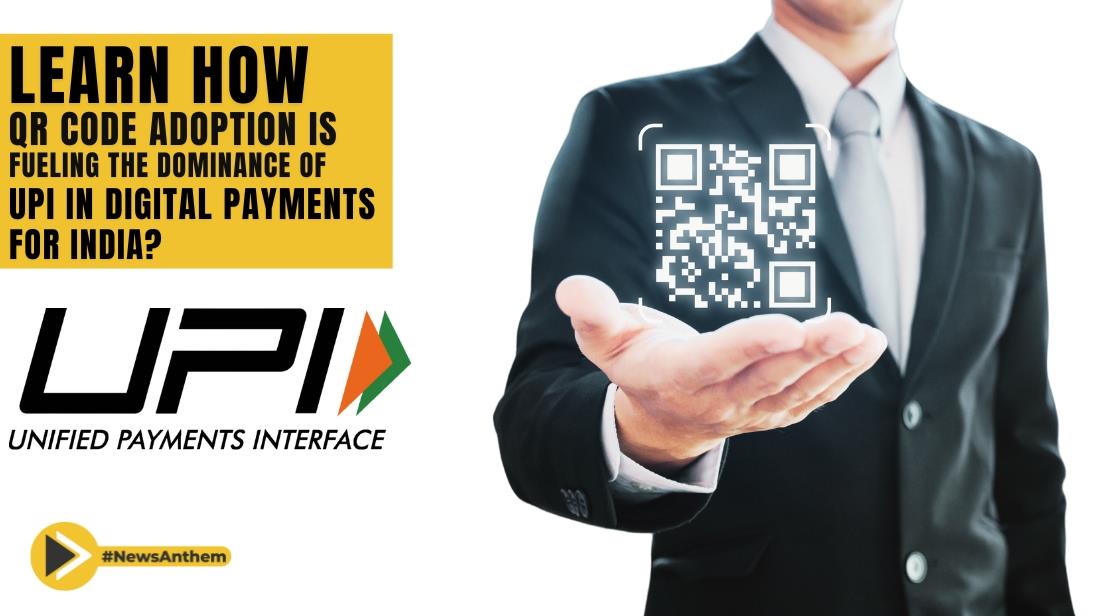Learn How QR Code Adoption Is Fueling The Dominance Of UPI In Digital Payments For India?

News Synopsis
QR Codes Propel UPI's Continued Success
India's flagship payment platform, the Unified Payments Interface (UPI), has maintained its position as the most popular method for digital payments in the nation, thanks to the widespread use of Quick Response (QR) codes. A report by Worldline India on India's digital payments revealed that the use of QR codes increased by 56% in 2022. This growth has translated into higher transaction volumes and values for UPI, solidifying its dominance in the market.
UPI's Impressive Transaction Metrics
In 2022, UPI processed over 74 billion transactions, totaling US$1.54 trillion (Rs. 126 trillion). These figures represent a 54% increase in the value of transactions and a 70% year-over-year (YoY) growth in the volume of transactions. Furthermore, UPI processed 84 billion transactions in FY23, amounting to USD 1.70 trillion (Rs. 139.09 trillion).
The Impact of QR Codes on UPI Transactions
The research credits the growth of QR codes as the driving force behind the increase in UPI transactions, which reached 237 million in December 2022, up from 152 million in January 2022. By December 2022, there were 4.96 million Bharat QRs and 237.94 million UPI QRs in circulation, marking a 65% increase from December 2021.
Person-to-Merchant Transactions Take the Lead
By the end of 2022, person-to-merchant (P2M) transactions would account for approximately 54% of UPI transactions in volume terms and 23% in value terms. UPI Person-to-Merchant (P2M) and Person-to-Person (P2P) payment methods were the most popular among consumers, with a market share of 40% and 44% in terms of transaction volume, respectively (UPI was 84% overall). In terms of transaction value, UPI P2P made up 66% of digital transactions (UPI was 84% overall), while UPI P2M accounted for 18%.
Major Players in India's Digital Payment Vertical
India's digital payment landscape is filled with numerous players vying for market share. Here's a brief overview of the major players in the industry:
1. PayTM:
Founded in 2010, Paytm is one of India's leading digital payment platforms. It offers services such as mobile recharges, bill payments, ticket bookings, and more. The platform also provides a mobile wallet and has recently expanded into the e-commerce space.
2. PhonePe:
Launched in 2015, PhonePe is a digital wallet and online payment platform that enables users to transfer money, pay bills, and recharge mobile phones. Owned by Flipkart, PhonePe has quickly gained traction in the market and has become a popular choice for UPI-based transactions.
3. Google Pay:
Formerly known as Tez, Google Pay is a digital wallet and online payment platform developed by Google. It allows users to make payments using UPI, mobile wallets, and debit/credit cards. Google Pay's user-friendly interface and robust security features have made it a popular choice among consumers.
4. Amazon Pay:
Amazon Pay is the digital wallet and payment platform of the e-commerce giant Amazon. Launched in 2017, Amazon Pay allows users to make payments for a wide range of services, including mobile recharges, bill payments, and shopping on Amazon's platform.
5. MobiKwik:
Founded in 2009, MobiKwik is a digital wallet and online payment platform that offers a wide range of services, including mobile recharges, bill payments, and online shopping. The platform has garnered a significant user base and continues to expand its service offerings.
Top 5 Countries with the Highest Digital Transactions
The digital payment landscape is evolving rapidly across the globe, with numerous countries witnessing a surge in digital transactions. Here are the top 5 countries with the highest digital transactions:
-
China: With its massive population and widespread adoption of digital payment platforms like Alipay and WeChat Pay, China leads the world in digital transactions. The country has embraced digital payments, with consumers using them for everything from online shopping to paying for public transportation.
-
United States: The United States is another major player in the digital payments space, with popular platforms like PayPal, Venmo, and Zelle enabling seamless online transactions. The country's robust e-commerce ecosystem and the growing popularity of contactless payments have contributed to the growth of digital transactions.
-
India: As highlighted in this article, India's digital payment landscape has experienced rapid growth, driven by platforms like UPI, Paytm, and PhonePe. The widespread use of QR codes and the government's push for a digital economy have also played a significant role in the country's digital transaction boom.
-
United Kingdom: The United Kingdom has a well-established digital payments ecosystem, with platforms like Apple Pay, Google Pay, and contactless card transactions being widely used. The growth of e-commerce and the shift towards a cashless society have propelled the UK's digital transaction volumes.
-
South Korea: South Korea is a leading country in terms of digital transactions, thanks to its advanced technological infrastructure and high smartphone penetration. Popular platforms like KakaoPay and Samsung Pay have enabled users to easily make digital payments for a wide range of goods and services.
ThinkWithNiche News Conclusion: UPI's Dominance in India's Digital Payments Landscape Bolstered by the Proliferation of QR Codes: The widespread use of QR codes in India has played a crucial role in the continued dominance of UPI as the nation's preferred digital payment platform. The impressive growth in transaction volumes and values, along with the popularity of person-to-merchant and person-to-person payment methods, demonstrates the strong potential for India's digital payment landscape to further evolve and expand.
You May Like









